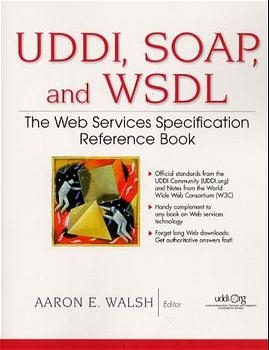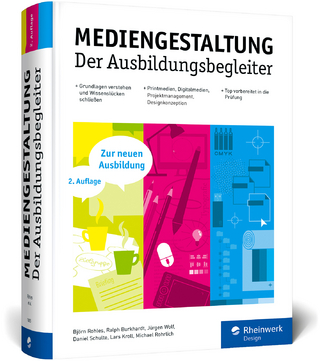
UDDI, SOAP, and WSDL
Prentice Hall (Verlag)
978-0-13-085726-2 (ISBN)
- Titel ist leider vergriffen;
keine Neuauflage - Artikel merken
If you want to build e-business apps., a few tools must be ready. Some of these tools are the officially sanctioned specifications for UDDI, ebXML and SOAP. Here, in one volume, PH PTR and Aaron Walsh have bound the most important specifications for e-business developers. In addition to providing the specifications, the book provides useful introductory material to each specification, and a design that allows for in-text "hyperlinking" between documents.
AARON E. WALSH is Chairman of Mantis Development Corporation, a development firm specializing in advanced multimedia and network technologies. He is Chairman of the Web3D Consortium's Universal Media technical working group, Chairman of the Web3D-MPEG group responsible for the convergence of Web3D and Motion Picture Experts Group (MPEG) technology, Co-chair of the Web3D Consortium's Intellectual Property Rights task group, and Web 3D Liaison to MPEG and the World Wide Web Consortium. An international best-selling technology writer, Walsh is author of the Prentice Hall PTR books Core Web3D, XHTML Example by Example, Java 3D API Jump-Start, and MPEG-4 Jump-Start. He is editor of ebXML: The Technical Specifications and ebXML: The Technical Reports.
Preface.
Acknowledgements.
I. UNIVERSAL DESCRIPTION, DISCOVERY AND INTEGRATION (UDDI) 1.0.
1. UDDI Executive White Paper.
The New Trading Environment. Challenges. Solutions. New Approach. UDDI Project. More Than Just a Specification. Summary.
2. UDDI Technical White Paper.
Abstract. Introduction. Overview. UDDI business registrations and the UDDI business registry. Using UDDI. Background. UDDI—the technical discovery layer. Next steps. Business discovery and UDDI. Future work. Technical overview. Four information types. Business information: the businessEntity element. Service information: the businessService and bindingTemplate elements. Specification pointers and technical fingerprints. The programmer's API. Built on SOAP. The Inquiry API. The UDDI invocation model. Recovery after remote Web service call failure. The Publication API. Security: Identity and authorization. Other information. Appendix A: UDDI information model. Resources.
3. UDDI Programmer's API 1.0.
UDDI Open Draft Specification 30 September 2000. Contents. Introduction. Document Overview. What is this UDDI anyway? Compatible registries. What are tModels? Classification and Identification information. Design & Architecture. Design Principles. Security. Versioning. SOAP Messaging. XML conventions. Error Handling. White Space. XML Encoding. API Reference. Three query patterns. The browse pattern. The drill-down pattern. The invocation pattern. Inquiry API functions. Publishing API functions. Special considerations around categorization. Appendix A: Error code reference. Error Codes. dispositionReport overview. Appendix B: SOAP usage details. Support for SOAPAction. Support for SOAP Actor. Support for SOAP encoding. Support for SOAP Fault. Support for SOAP Headers. Document encoding conventions—default namespace support. UTF-8 to Unicode: SOAP listener behavior. Appendix C: XML Usage Details. Use of multiple languages in the description elements. Valid Language Codes. Default Language Codes. ISSUE for Validation: XML namespace declaration. Support for XML Encoding. Appendix D: Security model in the publishers API. Achieving wire level privacy: All methods are secured via SSL. Authentication. Establishing credentials. Authentication tokens are not portable. Generating Authentication Tokens. Per-account space limits. Appendix E: Search Qualifiers. General form of search qualifiers. Search Qualifiers enumerated. Search Qualifier Precedence. Locale Details. Appendix F: Response message reference. Appendix G: redirection via hostingRedirector element. Special situations requiring the hostingRedirector. Using the hostingRedirector data. Stepwise overview. Appendix H: Details on the validate_categorization call. Appendix I: Utility tModels and Conventions. UDDI Type Taxonomy. UDDI Registry tModels. UDDI Core tModels—Taxonomies. UDDI Core tModels—Other. Registering tModels within the Type Taxonomy. References. Change History.
4. UDDI Data Structure Reference V1.0.
UDDI Open Draft Specification 30 September 2000. Contents. Introduction. Service discovery. Four data structure types. Core structure reference. Overall principles. Unique identifiers. Containment. The businessEntity structure. Structure specification. Descriptive matrix. Substructure breakdown. DiscoveryURLs. Contacts. BusinessServices. IdentifierBag. CategoryBag. The businessService structure. Structure specification. Substructure breakdown. BindingTemplates. The bindingTemplate structure. Structure specification. Substructure breakdown. AccessPoint. HostingRedirector. TModelInstanceDetails. The tModel structure. Two main uses. Defining the technical fingerprint. Defining an abstract namespace reference. Structure specification. Substructure breakdown. Appendix A: Using Identifiers. The identifier dilemma. Identifier characteristics. Using identifiers. Structure specification. Appendix B: Using categorization. Structure Specification. Appendix C: Response message reference. Appendix D: Data Field Lengths.
5. UDDI XML Schema 1.0 (1999).
6. UDDI XML Schema 1.0 (2001).
II. SIMPLE OBJECT ACCESS PROTOCOL (SOAP) 1.1.
7. W3C Simple Object Access Protocol (SOAP) 1.1.
W3C Note 08 May 2000. Abstract. Status. Table of Contents. Introduction. Design Goals. Notational Conventions. Examples of SOAP Messages. The SOAP Message Exchange Model. Relation to XML. SOAP Envelope. SOAP Header. SOAP Body. SOAP Fault. SOAP Encoding. Rules for Encoding Types in XML. Simple Types. Polymorphic Accessor. Compound types. Default Values. SOAP root Attribute. Using SOAP in HTTP. SOAP HTTP Request. SOAP HTTP Response. The HTTP Extension Framework. SOAP HTTP Examples. Using SOAP for RPC. RPC and SOAP Body. RPC and SOAP Header. Security Considerations. References. SOAP Envelope Examples. Sample Encoding of Call Requests. Sample Encoding of Response.
8. SOAP 1.1 External Hyperlinks.
9. SOAP 1.1 Envelope Schema.
10. SOAP 1.1 Encoding Schema.
III. WEB SERVICES DESCRIPTION LANGUAGE (WSDL) 1.1.
11. W3C Web Services Description Language (WSDL) 1.1.
W3C Note 15 March 2001. Abstract. Status. Table of Contents. Introduction. WSDL Document Example. Notational Conventions. Service Definition. WSDL Document Structure. Types. Messages. Port Types. Bindings. Ports. Services. SOAP Binding. SOAP Examples. How the SOAP Binding Extends WSDL. soap:binding. soap:operation. soap:body. soap:fault. soap:header and soap:headerfault. soap:address. HTTP GET & POST Binding. HTTP GET/POST Examples. How the HTTP GET/POST Binding Extends WSDL. http:address. http:binding. http:operation. http:urlEncoded. http:urlReplacement. MIME Binding. MIME Binding example. How the MIME Binding extends WSDL. mime:content. mime:multipartRelated. soap:body. mime:mimeXml. References. Notes on URIs. XML namespaces & schema locations. Relative URIs. Generating URIs. Wire format for WSDL examples. Example 1. Location of Extensibility Elements. Schemas. WSDL Schema. SOAP Binding Schema. HTTP Binding Schema. MIME Binding Schema.
12. WSDL 1.1: External Hyperlinks.
| Erscheint lt. Verlag | 18.4.2002 |
|---|---|
| Verlagsort | Upper Saddle River |
| Sprache | englisch |
| Maße | 177 x 234 mm |
| Gewicht | 632 g |
| Themenwelt | Mathematik / Informatik ► Informatik ► Grafik / Design |
| Mathematik / Informatik ► Informatik ► Web / Internet | |
| Wirtschaft ► Betriebswirtschaft / Management ► Allgemeines / Lexika | |
| ISBN-10 | 0-13-085726-2 / 0130857262 |
| ISBN-13 | 978-0-13-085726-2 / 9780130857262 |
| Zustand | Neuware |
| Haben Sie eine Frage zum Produkt? |
aus dem Bereich


